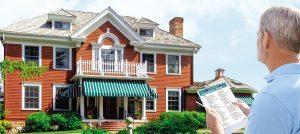 Maintaining an older home can seem like quite the undertaking for those who are unprepared. Whether your house is twenty, forty, or sixty years old, homes will continue to age, and homeowners will be faced with new and complicated repairs or maintenance as the years pass. Homes in the “mature” stages of life require a little more TLC than their younger counterparts. The ability to spot issues before they become nightmares and dealing with complications in a timely manner will save you money and time in the long run.
Maintaining an older home can seem like quite the undertaking for those who are unprepared. Whether your house is twenty, forty, or sixty years old, homes will continue to age, and homeowners will be faced with new and complicated repairs or maintenance as the years pass. Homes in the “mature” stages of life require a little more TLC than their younger counterparts. The ability to spot issues before they become nightmares and dealing with complications in a timely manner will save you money and time in the long run.
Arguably the most important part of maintaining an older home is detailed note taking. This process is vital to creating maintenance schedules and determining which aspects of the home should be cared for first. The first step in this process is digging up as much information on your house as possible. Not only should you know the year your house was built, but it is also important to jot down the dates of any major renovations, repairs, or additions. Compile all this information into a notebook or digital file so that it is easily accessible. Additionally, make sure to include the dates and findings of routine maintenance checks. Knowing your A/C unit was inspected three years ago won’t do you much good unless you also include the findings and possible points of worry for the future. Once all this information is logged, you can begin to create maintenance and repair schedules based on the average life expectancy of different aspects of your home.
The two most basic tips for maintaining an older home are: become comfortable with surprises and budget for said surprises. While these tips do hold a shred of truth, there are ways to prepare yourself and your home so that surprises can be kept to a minimum. The good news is that older homes were built well and meant to last. The use of higher quality materials and cheaper labor meant more time was put into building these magnificently sturdy homes. While the bones of your house may be strong, there is no reason to put them through unnecessary strain. Make sure your house is well insulated and dry, routinely check your roof for leaks, and perform repairs or replacements when necessary. Plumbing and electrical systems are sure to be deteriorating, but routine inspections will ensure that you have a decent timeline of their longevity. This will allow you to prepare and budget for repairs or replacements so that multiple expensive projects are not scheduled to take place in the same year. These projects are sure to put a dent in your wallet, but ignoring these issues will just result in higher prices. It would be better to pay for new pipes earlier than necessary than to wait until the old pipes burst and then be stuck replacing pipes, flooring, insulation, etc.
As is evident, a major theme of this article is preventive maintenance. Overgrown trees, poor yard drainage, and foundational cracks may often be overlooked and categorized as long-term problems. Unfortunately, these seemingly harmless issues a re the kind to haunt you years down the road in the form of a hefty bill. Maintaining an older home can seem like an endless money pit, but a silver lining can be found in all situations. Older homes were built to certain standards that may not meet the needs of the modern homeowner. Poor insulation and ancient electrical systems may be expensive or time-consuming to replace, but in the long-term replacing them can actually save you money in the form of reduced energy costs. Additionally, it is important to not only be aware of large issues but of small issues that can one day turn into large issues. When faced with potential plumbing or foundational issues, homeowners may put other chores, such as cleaning the gutters or replacing air filters, on the backburner. While seemingly harmless during the initial stages, the neglect of these tasks can result in damages to otherwise perfectly operational appliances or structures. Save yourself some money, and take care of things so that your list of repairs and replacements is not unnecessarily long.
Once the bones of the house are taken care of, many homeowners will be tempted to funnel funds into excessive renovations. While some renovations are necessary for energy efficiency purposes, others may just result in further issues down the line. It is important to consult with professionals before embarking on new projects because there may be unintended consequences as a result of the remodels. The great thing about old homes is that many of the materials and aspects of the home can be modified or repurposed to fit different needs. Take advantage of the vintage aspects of your home because countless other people are spending a pretty penny just to recreate what you already have!
Maintaining an older home can be a lot of work, but taking measures to be organized will help you prevent expensive surprises. While these tips provide a general outline of what needs to be done, each home is unique, and homeowners should take the time to learn about their house and its inner workings. Enjoy the comfort and charm of your older home knowing that you have taken steps to ensure its longevity.
Katerin Rodriguez
Home & Yard Magazine




